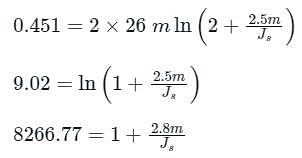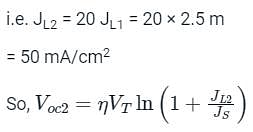Electronics and Communication Engineering (ECE) Exam > Electronics and Communication Engineering (ECE) Questions > For a particular intensity of incident light ...
Start Learning for Free
For a particular intensity of incident light on a silicon p-n junction solar cell, the photocurrent density (JL) is 2.5 mA/cm2 and the open-circuit voltage (Voc) is 0.451 V. Consider thermal voltage (VT) to be 25 mV. If the intensity of the incident light is increased by 20 times, assuming that the temperature remains unchanged, Voc (in volts) will be ___________.
(Take the ideality factor, η = 2 for Silicon)
(Take the ideality factor, η = 2 for Silicon)
Correct answer is between '0.51,0.62'. Can you explain this answer?
| FREE This question is part of | Download PDF Attempt this Test |
Most Upvoted Answer
For a particular intensity of incident light on a silicon p-n junction...
Voc = (Open circuit voltage) of a solar cell


Where η = 2 for Si p-n diode.
JL = Photo current density
Js = Saturation (Reverse) current density.
JL = Photo current density
Js = Saturation (Reverse) current density.
Calculation:
Given Voc = 0.451 V
For JL = 2.5 mA /cm2, n = 2 and VT2 = 25 mV.

Solving, we get Js = 3.024 × 10-7
If the intensity of the incident light is increased by 20 times, JL (Photocurrent density) also increases by 20 times

Putting values, we get

Given Voc = 0.451 V
For JL = 2.5 mA /cm2, n = 2 and VT2 = 25 mV.

Solving, we get Js = 3.024 × 10-7
If the intensity of the incident light is increased by 20 times, JL (Photocurrent density) also increases by 20 times

Putting values, we get

Free Test
FREE
| Start Free Test |
Community Answer
For a particular intensity of incident light on a silicon p-n junction...
Voc = (Open circuit voltage) of a solar cell


Where η = 2 for Si p-n diode.
JL = Photo current density
Js = Saturation (Reverse) current density.
JL = Photo current density
Js = Saturation (Reverse) current density.
Calculation:
Given Voc = 0.451 V
For JL = 2.5 mA /cm2, n = 2 and VT2 = 25 mV.

Solving, we get Js = 3.024 × 10-7
If the intensity of the incident light is increased by 20 times, JL (Photocurrent density) also increases by 20 times

Putting values, we get

Given Voc = 0.451 V
For JL = 2.5 mA /cm2, n = 2 and VT2 = 25 mV.

Solving, we get Js = 3.024 × 10-7
If the intensity of the incident light is increased by 20 times, JL (Photocurrent density) also increases by 20 times

Putting values, we get

Attention Electronics and Communication Engineering (ECE) Students!
To make sure you are not studying endlessly, EduRev has designed Electronics and Communication Engineering (ECE) study material, with Structured Courses, Videos, & Test Series. Plus get personalized analysis, doubt solving and improvement plans to achieve a great score in Electronics and Communication Engineering (ECE).

|
Explore Courses for Electronics and Communication Engineering (ECE) exam
|

|
Similar Electronics and Communication Engineering (ECE) Doubts
For a particular intensity of incident light on a silicon p-n junction solar cell, the photocurrent density (JL) is 2.5 mA/cm2 and the open-circuit voltage (Voc) is 0.451 V. Consider thermal voltage (VT) to be 25 mV. If the intensity of the incident light is increased by 20 times, assuming that the temperature remains unchanged, Voc (in volts) will be ___________.(Take the ideality factor, η = 2 for Silicon)Correct answer is between '0.51,0.62'. Can you explain this answer?
Question Description
For a particular intensity of incident light on a silicon p-n junction solar cell, the photocurrent density (JL) is 2.5 mA/cm2 and the open-circuit voltage (Voc) is 0.451 V. Consider thermal voltage (VT) to be 25 mV. If the intensity of the incident light is increased by 20 times, assuming that the temperature remains unchanged, Voc (in volts) will be ___________.(Take the ideality factor, η = 2 for Silicon)Correct answer is between '0.51,0.62'. Can you explain this answer? for Electronics and Communication Engineering (ECE) 2024 is part of Electronics and Communication Engineering (ECE) preparation. The Question and answers have been prepared according to the Electronics and Communication Engineering (ECE) exam syllabus. Information about For a particular intensity of incident light on a silicon p-n junction solar cell, the photocurrent density (JL) is 2.5 mA/cm2 and the open-circuit voltage (Voc) is 0.451 V. Consider thermal voltage (VT) to be 25 mV. If the intensity of the incident light is increased by 20 times, assuming that the temperature remains unchanged, Voc (in volts) will be ___________.(Take the ideality factor, η = 2 for Silicon)Correct answer is between '0.51,0.62'. Can you explain this answer? covers all topics & solutions for Electronics and Communication Engineering (ECE) 2024 Exam. Find important definitions, questions, meanings, examples, exercises and tests below for For a particular intensity of incident light on a silicon p-n junction solar cell, the photocurrent density (JL) is 2.5 mA/cm2 and the open-circuit voltage (Voc) is 0.451 V. Consider thermal voltage (VT) to be 25 mV. If the intensity of the incident light is increased by 20 times, assuming that the temperature remains unchanged, Voc (in volts) will be ___________.(Take the ideality factor, η = 2 for Silicon)Correct answer is between '0.51,0.62'. Can you explain this answer?.
For a particular intensity of incident light on a silicon p-n junction solar cell, the photocurrent density (JL) is 2.5 mA/cm2 and the open-circuit voltage (Voc) is 0.451 V. Consider thermal voltage (VT) to be 25 mV. If the intensity of the incident light is increased by 20 times, assuming that the temperature remains unchanged, Voc (in volts) will be ___________.(Take the ideality factor, η = 2 for Silicon)Correct answer is between '0.51,0.62'. Can you explain this answer? for Electronics and Communication Engineering (ECE) 2024 is part of Electronics and Communication Engineering (ECE) preparation. The Question and answers have been prepared according to the Electronics and Communication Engineering (ECE) exam syllabus. Information about For a particular intensity of incident light on a silicon p-n junction solar cell, the photocurrent density (JL) is 2.5 mA/cm2 and the open-circuit voltage (Voc) is 0.451 V. Consider thermal voltage (VT) to be 25 mV. If the intensity of the incident light is increased by 20 times, assuming that the temperature remains unchanged, Voc (in volts) will be ___________.(Take the ideality factor, η = 2 for Silicon)Correct answer is between '0.51,0.62'. Can you explain this answer? covers all topics & solutions for Electronics and Communication Engineering (ECE) 2024 Exam. Find important definitions, questions, meanings, examples, exercises and tests below for For a particular intensity of incident light on a silicon p-n junction solar cell, the photocurrent density (JL) is 2.5 mA/cm2 and the open-circuit voltage (Voc) is 0.451 V. Consider thermal voltage (VT) to be 25 mV. If the intensity of the incident light is increased by 20 times, assuming that the temperature remains unchanged, Voc (in volts) will be ___________.(Take the ideality factor, η = 2 for Silicon)Correct answer is between '0.51,0.62'. Can you explain this answer?.
Solutions for For a particular intensity of incident light on a silicon p-n junction solar cell, the photocurrent density (JL) is 2.5 mA/cm2 and the open-circuit voltage (Voc) is 0.451 V. Consider thermal voltage (VT) to be 25 mV. If the intensity of the incident light is increased by 20 times, assuming that the temperature remains unchanged, Voc (in volts) will be ___________.(Take the ideality factor, η = 2 for Silicon)Correct answer is between '0.51,0.62'. Can you explain this answer? in English & in Hindi are available as part of our courses for Electronics and Communication Engineering (ECE).
Download more important topics, notes, lectures and mock test series for Electronics and Communication Engineering (ECE) Exam by signing up for free.
Here you can find the meaning of For a particular intensity of incident light on a silicon p-n junction solar cell, the photocurrent density (JL) is 2.5 mA/cm2 and the open-circuit voltage (Voc) is 0.451 V. Consider thermal voltage (VT) to be 25 mV. If the intensity of the incident light is increased by 20 times, assuming that the temperature remains unchanged, Voc (in volts) will be ___________.(Take the ideality factor, η = 2 for Silicon)Correct answer is between '0.51,0.62'. Can you explain this answer? defined & explained in the simplest way possible. Besides giving the explanation of
For a particular intensity of incident light on a silicon p-n junction solar cell, the photocurrent density (JL) is 2.5 mA/cm2 and the open-circuit voltage (Voc) is 0.451 V. Consider thermal voltage (VT) to be 25 mV. If the intensity of the incident light is increased by 20 times, assuming that the temperature remains unchanged, Voc (in volts) will be ___________.(Take the ideality factor, η = 2 for Silicon)Correct answer is between '0.51,0.62'. Can you explain this answer?, a detailed solution for For a particular intensity of incident light on a silicon p-n junction solar cell, the photocurrent density (JL) is 2.5 mA/cm2 and the open-circuit voltage (Voc) is 0.451 V. Consider thermal voltage (VT) to be 25 mV. If the intensity of the incident light is increased by 20 times, assuming that the temperature remains unchanged, Voc (in volts) will be ___________.(Take the ideality factor, η = 2 for Silicon)Correct answer is between '0.51,0.62'. Can you explain this answer? has been provided alongside types of For a particular intensity of incident light on a silicon p-n junction solar cell, the photocurrent density (JL) is 2.5 mA/cm2 and the open-circuit voltage (Voc) is 0.451 V. Consider thermal voltage (VT) to be 25 mV. If the intensity of the incident light is increased by 20 times, assuming that the temperature remains unchanged, Voc (in volts) will be ___________.(Take the ideality factor, η = 2 for Silicon)Correct answer is between '0.51,0.62'. Can you explain this answer? theory, EduRev gives you an
ample number of questions to practice For a particular intensity of incident light on a silicon p-n junction solar cell, the photocurrent density (JL) is 2.5 mA/cm2 and the open-circuit voltage (Voc) is 0.451 V. Consider thermal voltage (VT) to be 25 mV. If the intensity of the incident light is increased by 20 times, assuming that the temperature remains unchanged, Voc (in volts) will be ___________.(Take the ideality factor, η = 2 for Silicon)Correct answer is between '0.51,0.62'. Can you explain this answer? tests, examples and also practice Electronics and Communication Engineering (ECE) tests.

|
Explore Courses for Electronics and Communication Engineering (ECE) exam
|

|
Suggested Free Tests
Signup for Free!
Signup to see your scores go up within 7 days! Learn & Practice with 1000+ FREE Notes, Videos & Tests.
























